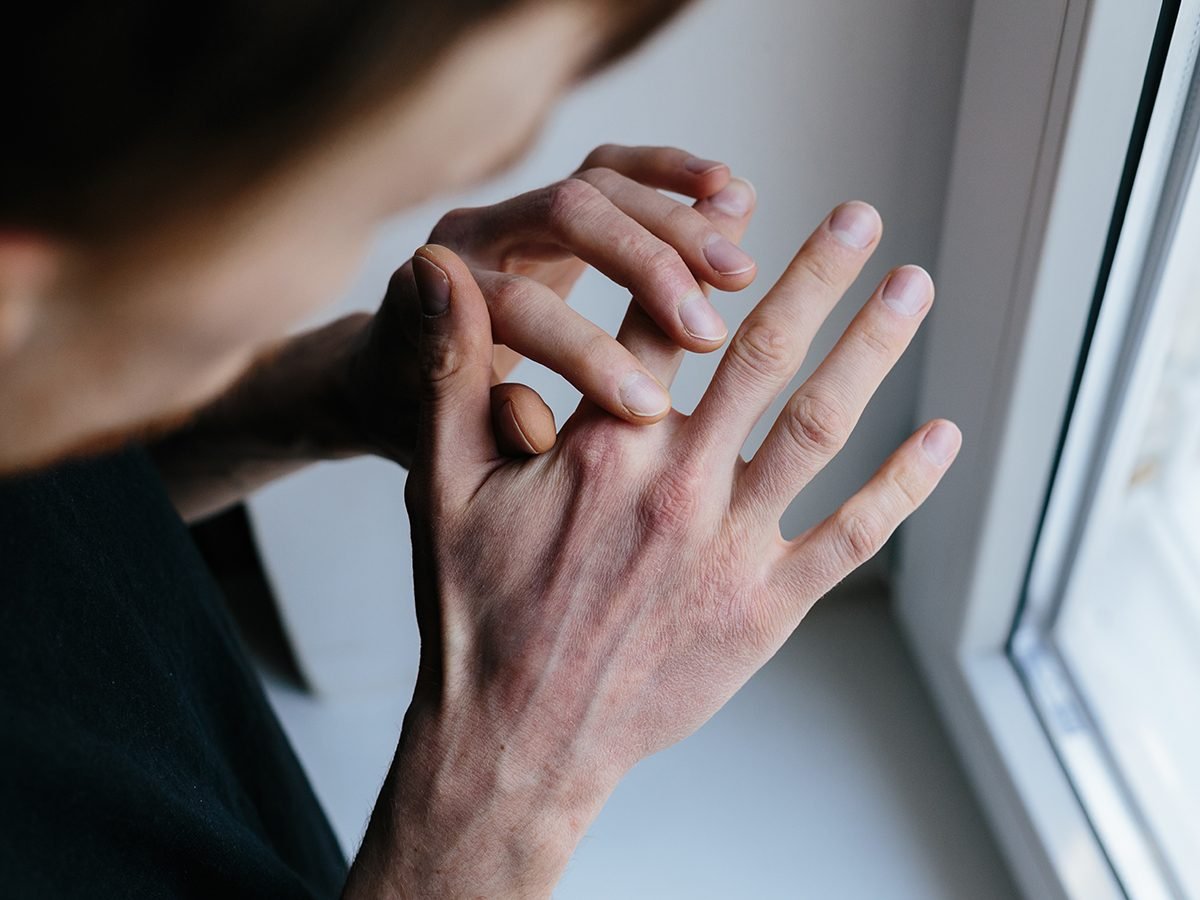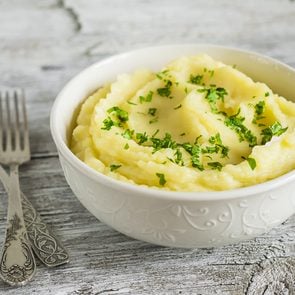Spencer Kroll, MD, has a book on his shelf that he used in medical school. In it, there’s information about a once-common practice for doctors.
When they’d shake the patient’s hand upon entering the exam room, the doctor would turn the hand slightly to look at the fingernails.
“It was a critical part of diagnosis, from that initial glance at the fingernails,” says Dr. Kroll, an internal medicine specialist in Morganville, New Jersey. “They looked at the colour and texture before we had these elaborate tests.”
White spots on fingernails, called leukonychia, can have a variety of causes—from small cosmetic issues to major, life-threatening illnesses. Luckily, it’s rarely the latter. While there are a few types, the most common one is called leukonychia punctata. It’s often seen in children who can be harder on their nails than adults are, says Sunitha Posina, MD, an internist in New York City.
Here are the most common reasons you might have white spots on your fingernails (or toenails).
What white spots on your nails could mean
Trauma to the nail
If you’ve ever hit your nail on something, you may have developed white spots from the trauma to the nail. In addition, you can also have this happen if there’s trauma to “the matrix, the base of where the nail forms,” says Emmanuel Loucas, MD, a dermatologist at Water’s Edge Dermatology in Florida.
In this case, the spots may take a while to go away, as nails grow slowly. This type of minor trauma can also result in fingernail ridges rather than white spots.
“Nails grow at a variable rate—they grow more in the wintertime and in colder months,” Dr. Kroll says.
But it can take several months to a year for nails to grow. “So if they were damaged, or there was a clear inciting event…it’s reasonable to track that event and wait several months” if there are no other symptoms, he adds.
Manicures, artificial nails, and other nail treatments
Ever had an amazing manicure, only to realize those artificial tips you had glued on your nail did some damage? This also counts as trauma to the nail, according to Dr. Kroll, and can take a while to grow out.
It’s not just nail tips that are the culprits, but a variety of beauty treatments. “There can be an allergic reaction to something topically on the fingers, from nail lacquers to fake nails to other topical applications,” he says.

Psoriasis or eczema
“Your nails are an extension of your skin, and in actuality, a type of skin,” says Dr. Loucas. So some conditions that can affect your skin can also affect your nails.
Psoriasis and eczema are skin conditions characterized by itching, rashes, and redness. These can manifest in the nails as well as your skin, resulting in nail whitening, says Dr. Loucas.
Psoriasis of the nails can look like thickening and whitening on the nails. It can also look like pitted, white dots, he says. Eczema can cause ridges, discolouration, and thickening. A dermatologist can help you find treatments that work. (Here are six common rashes, decoded.)
Fungus
If you’ve spent some time in your gym’s shower, a swimming pool, or other moist location, you may be experiencing nail fungus, especially on toenails. Fungus, says Dr. Loucas, can look like nail thickening and white colouring. If it’s extensive, then the whiteness and thickening can involve the entire nail.
Fungus is also commonly confused with psoriasis, he says. In order to diagnosis the condition properly, your doctor might take a clipping or scraping from your nails and send it off to a lab to identify if a fungus is causing an infection. Oral, topical, laser, and surgical treatments can help treat a nail fungus problem, depending on the severity.
COVID-19
One of the least well-known symptoms of COVID-19 involves your toes and toenails. They’ve been nicknamed “COVID toes,” and can be the only indication someone has COVID-19. Dr. Kroll explains that while this symptom typically involve red toes, sometimes patients might also experience pale nail beds: “It can look whitish and could be seen in fingernails as well,” he says.
The American Academy of Dermatology recommends hydrocortisone cream to relieve symptoms. Patients should keep a close eye on other potentially more dangerous COVID-19 symptoms and follow up with a doctor if they think they need testing or treatment.
This can sometimes happen in relation to vascular problems from COVID-19, which includes blood vessels and circulation, says Dr. Kroll.
Vitamin/mineral deficiencies (a hotly debated one)
Your grandmother might have told you that those white spots are because you are calcium deficient, and you need to drink more milk. Doctors and researchers disagree as to whether she’s right or wrong. Some say vitamin and mineral deficiencies can be the cause, while others say this is a myth that has been disproven.
Vitamin D, calcium, and zinc deficiencies may be the problem, says Dr. Kroll. When he’s working with patients who may have white spots, he sometimes orders a blood test to check for deficiencies, he says. He also listens to the patient’s history thoroughly, paying special attention to their dietary history and nutritional intake. “It’s important to listen for misconceptions,” he says.
Dr. Loucas says there’s been a lot of controversy and literature on both sides of the argument. “In general, calcium and other mineral deficiencies aren’t thought to cause leukonychia,” he says.
More serious conditions
More rarely, white spots can be a sign of a more serious condition, such as an autoimmune disease, heart disease, or kidney failure. If you are only experiencing white spots and no other symptoms, Dr. Kroll is much less concerned and suggests simply keeping an eye on the issue.
However, he says if you are having white spots along with other serious symptoms, you should be evaluated immediately. These symptoms include shortness of breath, chest pain, palpitations, and swollen ankles.
Dr. Posina cautions to look for other nail conditions accompanying the white spots. “Nail brittleness, discolouration, ridges, and grooves might be indicative of more systemic changes that need to be thoroughly evaluated,” he says.
A study published in 2016 in the Indian Journal of Dermatology lists many possible diseases associated with leukonychia. Those include: HIV, liver cirrhosis, Kawasaki disease (an illness that causes inflammation in blood vessels), arsenic or lead poisoning, renal failure, and liver failure. Leukonychia can also follow an acute illness.
Medication side effects
White spots on your nails can be one of the lesser-known side effects of some medications. Dr. Posina lists common culprits, but you should tell your doctor about all side effects from medications:
- Sulfur drugs like some antibiotics used to treat skin infections and other bacterial infections (for example: Bactrim, Dapsone)
- Water pills like furosemide (Lasix) and hydrochlorothiazide (Microzide)
- Arthritis pain medication like celecoxib (Celebrex)
- Diabetes medications such as glimepiride (Amaryl) and glyburide
- Sulfasalazine used to treat Crohn’s disease, ulcerative colitis, and rheumatoid arthritis
- Some chemotherapy drugs
The bottom line
While leukonychia may be unsightly, or may cause you to worry if you have a bigger problem, it’s nothing to worry about most of the time. Usually it’s just from bumping your nail on the corner of that kitchen island one too many times. To rule out more serious conditions, don’t hesitate to discuss your nail health with your doctor.
Next, find out 20 symptoms you should never ignore.
One thing is for sure, we’ve learned a ton of helpful kitchen hacks the past few months thanks to TikTok…like how to whisk properly, and the best way to clean burnt pots. Most recently, we learned that there is a right way and a wrong way to store your eggs. Here’s what we discovered.
How to Store Eggs to Keep Them Super-Fresh
Besides focusing on getting a container of eggs home and into the fridge without breaking one, it turns out we should be paying a little more attention to how we’re storing them. According to TikTok user theshilohfarm, there is a right way when it comes to storing eggs in the fridge…and it’s probably not how you’ve been doing it. Eggs should be stored with the pointed end down and the blunt, more rounded side facing up. Why? It will keep the yolk more centred inside the egg and will help your eggs stay fresh longer.
@theshilohfarmYou’re doing it wrong. #egg #eggs #chicken #chickens #tip #wow #cool #lol #fyp #foryou #foryoupage #shilohfarm #fact #facts #pets #animals #tips #food♬ Acoustic Guitar Stroll – Dow Brain
One follower commented, “Just made me go into my fridge and check every egg in my container!” Same for us.
How Does This Work
Turns out there is an air bubble at the blunt end of every egg. Air and bacteria enter the egg through the blunt end into the air sac located there. By storing eggs blunt end up, the pocket of air stays away from the yolk, which is far more likely to be contaminated by any bacteria that enters the egg than the non-bacteria friendly white. Now you know!
Now that you know how to store eggs, find out the right way to put a garbage bag in the trash can.
I was born on October 14, 1934, in Osler, Saskatchewan, on our family’s mixed farm located 20 miles north of Saskatoon. The CN Railway line linking Saskatoon and Prince Albert ran right between our two quarters of land. The railroad was always a source of excitement for our family of ten, four boys and six girls. I was number six.

Rural Roots
The ancestors of both of my Mennonite parents, Henry and Elizabeth (née Wiens) Peters, were originally from Holland, living there in the mid-1600s. Later, the Peters family lived in and migrated through Germany, which was then Prussia, and later moved into Ukraine, where they remained for more than 80 years. In 1874, the Peters arrived in Manitoba and the Wiens did so in 1875. It was my “Great-Grandpa Henry” and my “Great-Grandma Susanna” who, in 1896, purchased and built up what was to become the Peters’ first true family homestead in Canada—near Neuanlage, Saskatchewan.
In 1915, my grandparents Abraham and Margaretha created a new home base for the family in the town of Osler, a few miles down the road, with the purchase of Osler House. This home came with surrounding property and was built in 1908 by J.S. Grant, who originally intended the building to be a hospital. He hoped that his son would become the local doctor after graduation from medical school. Mr. Grant’s son, however, decided to remain in Winnipeg to pursue medicine, and so Osler House was put up for sale. Grandpa and Grandma farmed the land and raised a family there until 1927.
Upon Grandpa’s retirement, the property was passed on to my dad; he and my mom farmed there until the 1950s. Most of my siblings and I were born in Osler House. As children we were taught to respect our elders and to “Do unto others as you would have others do unto you.”
We have many fond memories of those days. For example, during the Second World War, the federal government built a large airport for training pilots just a mile away from our farm and, for the next five years, we constantly had planes circling above us. I recall that one day a pilot, who was flying rather low overhead as we were haying in the field, dropped down a box of sandwiches for us. Talk about an unexpected gift from above!
Western Exposure
In 1950, our parents decided to rent out the farm and move to Quesnel, B.C. We had the greatest train ride you could imagine through Jasper and the Rocky Mountains before settling into our new home. I got a job working in a plywood factory at $1.10 per hour, putting in 44 hours a week. A year later, I became a lift truck operator there, at $1.69 an hour. Things were looking up!
In 1953, my parents decided to sell Osler House and the farmland outright; the new owners had the aging home and barn taken down (the house was rebuilt in the mid-1960s). More recently, I passed along several interesting items from the original home to the Osler Museum, with the aim of helping to keep the memory of this lovely old place alive in the community.

My Teammate in Life
In October 1954, back in Quesnel, I went to my very first dance, where I met a pretty young woman named Betty Stensland. In spite of me nervously stepping on her toes as we danced, we hit it off and began to go steady. Before long, we made plans to be married on December 29, 1955 in Quesnel, and so Betty became my tax-exemption bride!
After a short honeymoon, we settled in Grand Prairie, Alberta, where I began a new job with Lloyd’s Tire. Then, in February 1962, we moved to Grimshaw, Alberta—Mile “0” on the MacKenzie Highway—where I became the branch area manager for Dunlop Canada Ltd.
In 1964, I was asked to transfer south to the beautiful city of Lethbridge as branch area manager and, two years later, I was given the opportunity to take over the company’s largest location and sales area in Calgary.
While moving from one location to the next—and indeed the work itself—was challenging, it was rewarding in so many ways. Most importantly, it provided us with the means to raise a family of our own. It also enabled us to see many parts of Western Canada and to occasionally travel further afield. In 1967, Betty and I took a trip to see Expo ’67 in Montreal and then we enjoyed a train ride to Quebec City. By then we had three young daughters, who stayed with Grandma Peters for the ten days we were away. We missed the kids dearly but really enjoyed the trip. The whole experience gave us a new appreciation of our great country and our new flag.
On a Roll
In the spring of 1968, backed by a wealth of firsthand experience in the tire and battery business, we packed up our car and went to the Okanagan Valley in British Columbia, with the intention of relocating there and starting up our own tire distribution centre. By September of that year, we had settled in Vernon, B.C. Betty and I, together with my brother Alf, became equal partners in our own business. We set up shop next to the former NOCA Dairy and so “Peters Tirecraft” was born. Our slogan, and our approach to customers, was You Really Matter to Us!
My former employer Dunlop Canada offered us their line of Remington tire products on a factory-direct basis, which made us very competitive right from the start. In 1973 we purchased a prime commercial property on 27th Street and had our new tire store and warehouse built.
By 1978, my brother Alf found that the pressure of running a family business was getting to be too much, so we came to an agreement to buy out his share. We doubled our warehouse space in 1980 to accommodate a growing wholesale network of 250 dealers and six Tirecraft stores. Firestone and Dayton came to us with an exclusive factory-direct distributorship offer, which we were glad to accept.
In the 1980s, I had two opportunities to reassess my life during hospital stays for major surgery. Times were getting tough by the mid ’80s; although Tirecraft was still growing, the pace was slower. In 1988, after 34 years in the industry, including 21 nurturing Tirecraft, Betty and I decided to sell our business. We closed the deal in November 1988. I’m pleased to say that under the new ownership, Tirecraft continues to expand right across Canada.

Giving Back
With that chapter of our lives closed, I was able to devote more time to the Rotary Club, which I joined in 1975. In 1979, I was appointed as a special representative to form a new club in Armstrong, B.C. I also served as club president of the Vernon Rotary Club in 1982-83. In 1990, I was nominated to become the Rotary district governor, overseeing 50 clubs. While I was preparing to step into that role, an opportunity came up with Operation Eyesight Universal, a worthy cause backed by our Rotary club and Rotary International. As an incoming governor, I was invited to travel to India to visit the hospitals and eye-care camps benefiting from Rotary support. I saw first-hand how the funds raised were put to good use to buy equipment and provide medical assistance with cataract removals and lens implants, as well as the treatment of eye infections and glaucoma. Over the years, Betty and I have travelled and contributed to many Rotary projects in Canada, the U.S.A. and abroad.
Throughout it all, our crowning achievement are our three wonderful daughters, who give Betty and me a real sense of joy and make us proud. I walked each one down the aisle, first Sheila, next Sharon and then Sandra.
Our family today also includes five grandchildren plus three great grandchildren, all of whom need our love and attention. The community fundraisers and other voluntary work both Betty and I continue to do through our church and Rotary keep us active.
Canada has indeed been good to our family, and I would like to thank Betty, my love and my teammate in life, for standing with me for 63 years now. The joy and pleasure of serving is ours.
Next, find out what Prairie life was like during the Great Depression.
Can stress cause an ulcer?
Although your mom may have warned you as a child that excessive worrying could burn a hole in your stomach, she was on shaky ground, scientifically speaking. She’s right about the pain and discomfort that can accompany stress and anxiety; it’s just not necessarily an ulcer that’s to blame.
According to Dr. Dan Sadowski, a professor in the faculty of medicine at the University of Alberta, people under stress often simultaneously experience dyspepsia, or indigestion, which leads to belching, bloating and burning pain. Although stress isn’t a direct cause of that indigestion, the flood of cortisol that’s triggered by our body’s response to stress causes you to feel the pain more keenly. And, on top of that, when we’re stressed we may be apt to drink more alcohol, which exacerbates the problem. (Read up on what booze does to your body.) Thankfully, in the majority of cases, you can successfully treat dyspepsia symptoms with over-the-counter antacids.
So if stress doesn’t cause ulcers, what does?
A stomach ulcer, which is a small sore in your gastrointestinal tract, has two main causes. One is the use of non-steroidal anti-inflammatory drugs (NSAIDs)—such as ibuprofen or naproxen—which are commonly prescribed for pain relief. While they’re safe in the short term, if used over a long period of time for chronic conditions like migraines, arthritis or back issues, they can lead to irritation and erosion of the stomach lining—ultimately causing an ulcer. This can occur in as little as two months, or even less.
The second main cause of ulcers is an infection with Helicobacter pylori (H. pylori), a common bacterium found in the stomach lining that spreads through contaminated food and water or direct contact with someone who has it. According to Dr. Christopher Teshima, a gastroenterologist at St. Michael’s Hospital in Toronto, the infection usually occurs in childhood, although only 20 per cent of infected children have symptoms. Most cases of H. pylori—which is also a risk factor for cancer—will never cause an issue, with only 10 to 15 per cent of infected Canadians developing an ulcer. Infections are more common in countries with inadequate water sanitization, and seniors are more vulnerable.
How do you know if you do indeed have an ulcer?
The most common symptom of a gastric ulcer is a gnawing or sharp pain midway between the breastbone and navel—the sensation of acid burning the area of the stomach where the ulcer is located. Confusing matters, ulcers can cause dyspepsia. However, if it’s an ulcer, you’re more likely to experience pain at night and see black, bloody or tar-like stools.
If you’re experiencing ulcer-like pain, see a doctor to test for H. pylori. If you’re vomiting blood or having black stools, this could indicate an ulcer is bleeding, which is considered a life-threatening emergency and requires an immediate trip to a hospital. At the ER, a doctor will scope your stomach and cauterize the bleeding. (Find out what your poop can reveal about your health.)
How is an ulcer treated?
If your ulcer is NSAID-related, your doctor will likely advise you to reduce your dose, choose an alternative medication such as acetaminophen, or opt for exercise and physical therapy. Often, patients will be prescribed a proton-pump inhibitor (PPI), which lowers the levels of acid in your stomach.
If symptoms continue, an endoscopy, or stomach scope, can be performed to rule out another condition, like cancer. For many H. pylori infections, a two-week course of a medication that combines antibiotics, an antifungal and a proton-pump inhibitor will usually clear the bacteria, though some patients may need to take the drug for a few months.
To ease symptoms in the meantime, antacids and over-the-counter acid blockers can help.
Next, check out 10 ways to improve gut health.
My doctor broached the prospect of a colonoscopy in jaunty nautical terms, pitching the procedure as a journey of discovery—a cruise where a periscope would peruse 1,500 millimetres of previously uncharted territory. Somehow, the distance covered by that voyage sounded even further than the Vancouver-to-Honolulu cruise I’d once considered. Plus, who really wants a snapshot of their sigmoid colon? I told the doctor I’d always thought of Freud as more of a psychoanalytical guy. How’d he manage to get a below-the-belt body part named after him?
Lacking a funny bone in his own anatomy, my physician replied that the sigmoid—the part of the large intestine that connects the descending colon to the rectum—was only a minor part of his planned photo shoot. No short jaunts for him. He clearly intended to max out his points on this endoscopic expedition. And just my luck: a cancellation had freed up a cabin with a view.
“Be prepped by Monday,” said Dour Doc.
“Prepped?”
“A well-prepared colon is a well-cleansed colon.”
Ah.
When it comes to the buffet offerings, your standard colonoscopy cruise cannot compete with the luxury liners. Care for clear consommé? A plop of yellow Jell-O? (There’s no crow’s nest bar or lido deck either.)
The purification process is fast-tracked by pick-me-ups with cheery names along the lines of “Clenzo-Prep.” Don’t be misled by luscious-looking orange slices or bestseller claims on product packaging—”Clenzo” and its cohorts are oral purgatives, a term as close to purgatory as it sounds.
“Clenzo” consists of citric acid (see tarted-up orange slice) complemented by magnesium oxide and sodium picosulfate. One moonlights as an insulator in industrial cables; the other tastes of crushed submarine parts.
When I first dumped this seemingly benign powder into water, I was surprised to see it fizz. The label warned: “Rarely, mixture may heat up. Allow to cool before drinking.” Listen up, those who snoozed through chemistry class. Nuclear fission is happening right here in your glass! Swallow, and the contents are en route to distant, unsuspecting parts.
In the mother of understatements, the box advised maintaining powder-room access. Dawn found me two pounds lighter, clean as the proverbial whistle and ready to board. Anchors aweigh!
My good humour lasted until a nurse came to hook up my IV. They’re going to goof around in my gastrointestinal tract! I demanded to know which painkillers had been prescribed, grabbed my phone and googled. One was more potent than morphine, the other “sometimes used in executions by lethal injection.” That ought to do the trick.
The next thing I remember is expounding on the merits of the best pumpkin loaf I’d ever tasted. “We do hear that a lot,” said the amiable nurse. Okay, I seemed to still be tripping. At least I hadn’t felt a thing, and better yet, Doc said I’d sailed through the examination.
Considering booking a cabin on a colonoscopy cruise? If your doctor says you’re a candidate for a sigmoid snap, smile. You’re going to love the pumpkin loaf—and the peace of mind when it’s all, ahem, behind you.
Next, check out 50 funny doctor jokes that’ll have you in stitches.
When chilly weather starts to creep in, there’s only one food that can really warm my bones: a hearty and flavour-packed beef stew. Pair a big bowl of it with a slice or two of buttered homemade bread and I’m as cozy as can be. (Here are 35 easy bread recipes anyone can bake!)
My go-to is Taste of Home’s Deputy Editor James Schend’s beef stew recipe, which is hands-down the best beef stew I’ve ever had. Its complex flavour comes from the recipe’s use of paprika, rosemary and herbes de Provence. The stew isn’t too heavy, either. James’s secret ingredient is a splash of balsamic vinegar that brightens up the dish.
How to Make the Best Beef Stew
Ingredients:
- 1-½ pounds beef stew meat, cut into 1-inch cubes
- ½ teaspoon salt, divided
- 6 tablespoons all-purpose flour, divided
- ½ teaspoon smoked paprika
- 1 tablespoon canola oil
- 3 tablespoons tomato paste
- 2 teaspoons herbes de Provence
- 2 garlic cloves, minced
- 2 cups dry red wine
- 2 cups beef broth
- 1-½ teaspoons minced fresh rosemary, divided
- 2 bay leaves
- 3 cups cubed peeled potatoes
- 3 cups coarsely chopped onions (about 2 large)
- 2 cups sliced carrots
- 2 tablespoons cold water
- 2 tablespoons balsamic or red wine vinegar
- 1 cup fresh or frozen peas
Yield: 6 servings
Directions:
Step 1: Prep the beef
First, in a small bowl, toss your beef with ¼ teaspoon of salt. In a large bowl, combine 4 tablespoons of flour with the smoked paprika, then add a few pieces of beef in, turning until they’re lightly coated.
Tip from James: “Coating your beef in paprika-spiced flour adds a delicious smoky flavour and caramelization that really gives the meat some depth.”
Step 2: Get cookin’
In a Dutch oven over medium heat, brown your coated beef in oil until it starts to get some colour.
Next, stir in the tomato paste, herbes de Provence and garlic, stirring until they’ve darkened in colour and have become fragrant. Pour in the wine and let the pot come to a slight boil, making sure to scrape up all the bits and pieces that have crusted to the bottom of the Dutch oven. They have tons of flavour!
Once the wine has reduced by half (which should take about 5 minutes) add the beef broth, 1 teaspoon of rosemary and bay leaves, then let it all come to a boil. Cut the heat, cover your Dutch oven and let the stew simmer until the meat is almost tender, about an hour and a half.
Tips from James: “I love Cento’s tomato paste in a tube because you can squeeze out only as much as you need and seal it back up for future use. No wasted leftovers!”
“Herbes de Provence is a unique blend that typically contains rosemary, thyme, oregano and lavender. It really elevates this stew.”
Step 3: Veg it out
Drop in your potatoes, onions and carrots in the stew, then let them simmer, covered, for 30 minutes, or until the veggies and meat are tender.
Tip from James: “While the recipe calls for potatoes and carrots, feel free to swap in your favourite firm winter veggies, like sweet potatoes, turnips or parsnips.”
Step 4: Finishing touches
Pick out the bay leaves and discard them. Then, in a small bowl, mix the remaining rosemary, salt, flour, water and balsamic vinegar until it’s smooth. Pour the mixture into the stew, allow it to come to a boil and then add in your peas.
After a few minutes, the stew should thicken and be ready to be served. Ladle into a bowl, pair with some crusty bread and dig in.
Tip from James: “Balsamic vinegar helps cut some of the fat and brightens the flavour. Check your balsamic’s label for an IGP designation. It indicates the vinegar was produced in Modena, Italy, an area known for its high-quality balsamic.”
Next, check out our best-ever slow cooker recipes.
Pretty much all of us are used to robocalls, info-marketers, and spam in our emails—and now scammers are targeting another form of communication: spam text messages. Don’t worry about deleting the messages, because there is a way to get rid of them for good. Here’s how to stop spam text messages and everything else you need to know about protecting yourself from phone spammers.
How to recognize spam text messages when you see them
There are some key signs that a text message isn’t legit. First, is the company’s name is in the text? Legitimate brands will let you know up front when they’re reaching out to you.
Second, look at the link. Is the name of the company in the link? If so, it’s probably legit. If the email contains a shortened link (scammers often use a bit.ly link), then don’t click it.
For example, https://www.ups.com/tracking/1234 lets you know that it will take you to a UPS tracking page.
On the other hand, the link http://bit.ly/3msAZfP gives you no clues, and could be from a scammer.
Scammers often use urgency to get you to take action without thinking. Catching you off-guard makes it easier to get you to click a link or answer with information.
Here’s an example of a smishing text that is vague, uses urgency tactics, and has a shortened link:
-
“You have a package that needs to be claimed ASAP. https://bit.ly/3msAZfP”
Other clues to look for include misspellings, bad grammar, slang, emojis, and typos. If the text doesn’t look professional, then it probably isn’t from a brand or company you trust.
Recent and ongoing text scams
Transaction Network Services (TNS), a robocall detection company, shared scams they have recently encountered with Readers’s Digest.
- Promises to remove negative information in your credit report for a fee
- Products offers, esp health and beauty products, iPhones and MacBooks
- Weight loss polls and research surveys, often with a gift card offer for participating
- Fundraising for a political campaign
- Free cash or quick loan offers, specifically $5,000
- Claims the recipient’s license is about to be revoked, and you must click a link to fix it.
- Get-rich-quick and be-your-own-boss offers
What is a phishing text?
Phishing texts, also called smishing, are attacks from cybercriminals to trick someone through text messages. Often these texts are aimed at stealing personal information or scamming the recipient out of money by asking for information about credit cards or bank accounts. Some will encourage you to click on a malicious link that will download malware to your phone. The malware then goes to work to steal your personal information.
What to do if you get a spam text
Your best step is to block the text sender—don’t click any links!—and report the spam. Then, delete the text from your phone.
Silence is always the best policy. Never respond to spam texts, not even with “stop.” “Many times, spam texts are sent by programs that send them out en masse,” explains Burton Kelso, chief tech expert with Integral, a computer and laptop repair service. “When you respond to a text message, you’re letting the spammer know that your number is legitimate and that encourages the spammer to continue.” Then, your verified number could be sold to other text spamming companies, which is why “silence is always golden,” he says.
How to block spam text messages
Block spam texts on an iPhone:
To block a text on your iPhone, follow these steps:
- Open the text.
- Tap the arrow next to the contact number that’s found at the top of the screen.
- Tap the gray “Info” button.
- Tap blue “Info” button.
- Scroll down and tap “Block this Caller.”
Block spam texts on an Android:
To block spam messages on an Android follow these steps:
- Open the text.
- Tap the three-dot menu in the upper right of the screen.
- Tap “Details.”
- Tap on “Block Contact.”
Note: Sometimes, Android phones, including the Samsung Galaxy S20, have a simpler process where all you need to do is tap on the three-dot menu and just tap on “Block.”
How to filter phishing texts so they don’t reach you
Filter text messages on an iPhone:
Your phone may also have the ability to filter out spam text messages automatically. Follow these steps:
- Go to the Settings app and tap “Messages.”
- Scroll down until you find the “Filter Unknown Senders.”
- Turn it on by swiping the button to the right. All messages from a number not in your contact list will be filtered to the “Unkown Senders” tab found under “Filters.”
Filter text messages on an Android:
To filter spam messages on an Android follow these steps:
- Go to the Messaging app and tap the three dots icon in the upper right-hand of the screen.
- Tap on “Settings,” then “Spam Protection.”
- Scroll down until you find “Enable Spam Protection.”
- Turn it on by swiping the button to the right.
If you can’t find the “Spam Protection” option, your phone doesn’t have a spam filtering feature. In this case, you’ll need to install a third-party filtering app.
Now that you know how to stop spam text messages, find out why you need to stop commenting on those viral Facebook memes.

I was shopping with my two-year-old granddaughter and her mother. We walked into a chocolate store where they were handing out free samples. The employee asked my granddaughter’s mother, “Any allergies?” before offering my granddaughter one. When my granddaughter finished her chocolate, she said to her mom, “More allergies, please.” —Arlene Fauvelle, Saskatoon
I find it amazing that my granddaughter needs to put plastic bags on her hands when she cracks eggs but she can pick up a worm from the garden with no problem. —Bonnie Bricker, Calgary
My four-year-old daughter woke up one morning and said she had so much work to do. I asked her what kind of work. She said she had to eat all her cookies she baked yesterday and pet the cats. —reddit.com
I was talking to my sleepy nine-year-old and, as a joke, offered her some of my coffee. She said, “I can’t drink coffee. I’m not an old person yet.” —@thisonesayz
How to portion-control your snacks: eat them in the presence of a three-year-old. You’ll be lucky to get two bites. —@pritikaryan
My six-year-old granddaughter told her mother that she was building a time machine. Her mother suggested that perhaps she should go back in time to when her mother was a little girl so that they could play together. My granddaughter replied, “I’m not going back that far!” —Nancy Freihaut, Oakville, Ontario
Here, more grandparents reveal the funniest things their grandkids have said.

My niece said she couldn’t get rid of her hiccups. I told her to breathe into a paper bag for a few minutes. Five minutes later, she came back into the room with a paper bag over her head and said, “It’s not working!” —Julianna Metin, Aldergrove, British Columbia
I told my daughter work was tough today and she patted my back and said, “Life isn’t always pickles and peaches.” —@dad_at_law
My eight-year-old son was talking to his grandpa about what it was like when his grandpa was growing up. He asked him what he watched on the iPad. His grandpa replied that there were no iPads then. My son, shocked, said, “I didn’t realize you were so poor as a kid.” —Shawna Dempsey-Mathieson, Watson, Saskatchewan
My new shoes came in the mail but they were too small. My 11-year-old said, “Just order two sizes up and if they’re too big, you’ll grow into them!” —reddit.com
My teenagers use so much slang I have no idea what they’re even saying anymore. I just hold my hand out for a fist bump and hope for the best. —@lovenlunchmeat
“Why are there so many tomorrows and only one today?” asked my three-year-old. This made me question everything about my current existence. —reddit.com
“Mommy, someone just lost their kitty!” is my three-year-old’s adorable way of telling me she stole someone’s toy. —@emslyce
My six-year-old: I can tie my shoes now. It’s easy.
Me: What’s your next challenge?
My six-year-old: Driving. —@xplodingunicorn
Next, check out these silly struggles every parent will relate to.
Arthur Chu’s Memorization Tricks
1. Practise tasks in an environment that’s as similar to the real situation as possible. (If your goal is to be a contestant on Jeopardy! yourself, that means more than just playing along with the TV show: You should stand up, have a buzzer in your hand and wait until the end of the clue to answer!)
2. Mnemonic devices such as acronyms and rhymes are helpful in cementing memory, though it’s ideal to practise enough that you no longer have to rely on them.
3. If you’ve memorized things in a certain order or structure—like a list—switching that up can improve your recall.
4. Strong mental images can help cement information in your head. Whenever Chu needs to remember the name of someone he’s just met, for example, he’ll make up a dirty joke in his head involving their name to ensure he’ll remember it the next time around.
5. Rituals and habits—like tying a tie and driving a car—stick in our brains much better than facts. If a pattern of behaviour becomes automatic, you can rely on your reflexive actions much more than if it’s something you have to think about.
Ready to put these memorization tricks to the test? See how you fare on our ultimate Canadian trivia quiz.
If making your own dog treats seems daunting, this is the recipe for you. Using food you probably already have at home, you can make 3-ingredient dog treats shaped like delicious little “meatballs” for your furry friend.
The treats don’t use added sugars or preservatives, so the nutrition factor is higher than in most store-bought versions. Plus, you can shape these little round dog biscuits into any size you like, depending on the size of your dog.
What Kind of Peanut Butter Is Safe for Dogs?
When it comes to your dog, not all peanut butters are created equal. While peanuts are perfectly safe—and most dogs enjoy the flavour—some peanut butters include sugar and xylitol. Sugar isn’t great for dogs, and xylitol is toxic to them. Make sure to pick a peanut butter with no xylitol or added sugar for these 3-ingredient dog treats. You can even buy peanut butter specially formulated for dogs.

3-Ingredient Dog Treats Recipe
Ingredients:
- ½ cup sliced apples
- ½ cup peanut butter
- 2 cups old fashioned oats
Editor’s Tip: If your dog loves cheddar dog treats, you can add ¼ cup shredded cheddar as a fourth ingredient.
Directions:
Step 1: Peel and slice the apple
Use an apple slicer or a sharp knife to slice up your fruit. I used apples because I had some on hand (and Olive, my Rottweiler, loves them). If you don’t have apples, you can substitute another fruit or veggie like pears, peaches or carrots.
Step 2: Cook the apple
Add the apple slices and two tablespoons of water to a small saucepan with a lid. Cook over low-medium heat for 10-15 minutes, or until apples are soft enough to mash.
Step 3: Mash the apple
Use a fork to mash the apples to an applesauce consistency. Some chunks are OK, but the smoother the mash, the easier it’ll be to mix in.
Step 4: Combine apples, peanut butter and oats
In a large bowl, mix the 3 ingredients together until they’re well-combined. The mix should be thick and a little sticky.
Step 5: Roll into balls
Roll a small amount of the oat mix between your palms to make a “meatball.” The size depends on the size of your dog. For larger pups, use ½ or 1 tablespoon of mix per meatball. For smaller dogs, use 1 teaspoon.
If too much mix is sticking to your hands as you roll the balls, refrigerate the bowl for 15 minutes to firm it up.
Step 6: Bake, cool and serve
Place the 3-ingredient dog treats on a parchment lined baking sheet and bake at 350°F for 15 minutes, until firm. Cool, then let your furry taste tester give them a try. My dog Olive loved these: The peanut butter kept her chewing long enough to really enjoy it, and then she came sniffing for more.

Tips For Making 3-Ingredient Dog Treats
This recipe comes together super quickly, but if you’re especially short on time, you can cook your apples (or whatever kind of fruit or vegetable you’re using) in the microwave. Just put the slices in a microwave-safe bowl with ¼ cup of water and cook on high a minute at a time until the apples are fork-tender. Then drain the water and continue with the rest of the recipe.
How Long Do the Treats Last?
These treats will last up to a week in the refrigerator, and they freeze well, too. For long-term storage, spread them in a single layer on a tray and freeze individually. Once they’re frozen, dump the tray into a freezer bag and store up to 6 months.
Can Humans Eat These Dog Treats?
Sure, and you might actually like them—just one more thing you and your dog have in common!
Next, find out the most popular dog breeds in Canada.




























